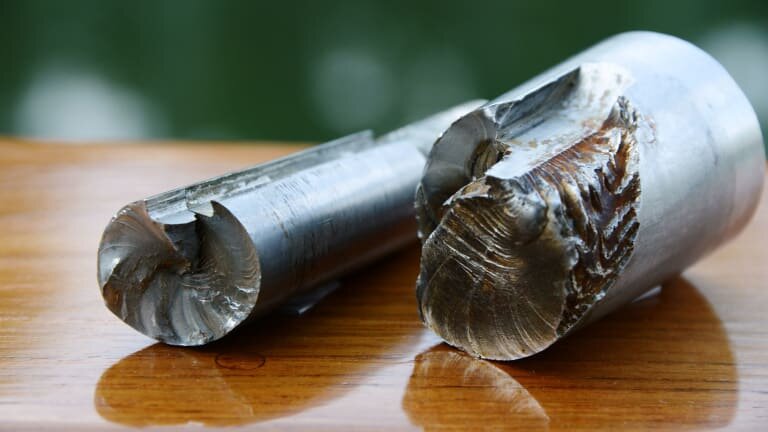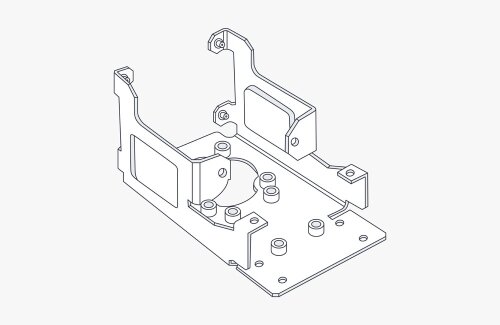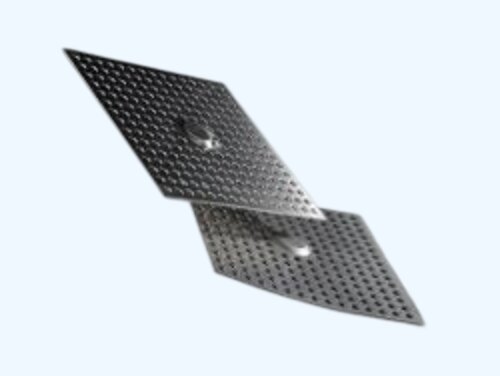يتطلب تصنيع القِطع الدقيقة مواصفات دقيقة، خاصةً عندما يتعلق الأمر بالخيوط الملولبة. يعاني العديد من المصنّعين من طرق الخيوط اللولبية التقليدية البطيئة والمعرضة للأخطاء والمكلفة عند كسر الأدوات. يتصدى التفريز اللولبي لهذه التحديات من خلال توفير تحكم فائق، وتقليل كسر الأدوات، وجودة لولبية استثنائية تلبي التفاوتات الصارمة.
تفريز الخيوط هو طحن الخيط التصنيع باستخدام الحاسب الآلي عملية تقوم فيها أداة دوارة متخصصة بإنشاء لولبة باتباع مسار أداة حلزونية. وخلافًا لطرق الثقب التقليدية، يسمح تفريز اللولبة بأداة واحدة لإنتاج أحجام مختلفة من اللولبة ويوفر دقة معززة لعمليات الثقب الداخلية والخارجية.
بصفتي مُصنِّعًا يتمتع بخبرة عميقة في مجال التصنيع الآلي الدقيق، سأقوم بتفصيل التفاصيل المعقدة لتقنية تفريز الخيوط وأشرح لماذا أصبحت الخيار المفضل لعمليات التصنيع الحديثة.
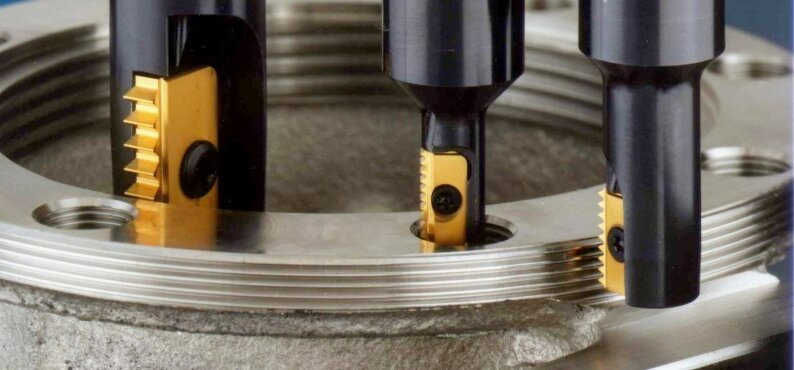
فهم الطحن اللولبي
يعمل التفريز اللولبي على إنشاء خيوط دقيقة من خلال عملية قطع متخصصة تجمع بين الحركة الدوارة والحركة الخطية. تدمج هذه العملية مبادئ القطع التقليدية مع تقنية التحكم الرقمي باستخدام الحاسوب الحديثة لتحقيق نتائج رائعة.
معنى مصطلح التفريز اللولبي
ينشر التفريز اللولبي أداة قطع دوارة تتحرك في مسار حلزوني لتشكيل اللولب. تتميز أداة القطع بمزامير متعددة ذات شكل جانبي مطابق لشكل اللولبة المطلوب. أثناء دوران الأداة، تزيل الأداة المواد تدريجياً لإنشاء هندسة اللولبة.
كيفية عمل ماكينات التفريز اللولبي
تتضمن العملية ثلاث حركات متزامنة. تدور أداة القطع حول محورها بينما تتبع مسارًا دائريًا، وتتحرك على طول محور الشُّغْلَة في نفس الوقت.
أثناء التشغيل، تقوم الماكينة بإقحام محاور متعددة في وقت واحد للحفاظ على التزامن المثالي بين دوران الأداة وحركتها على طول قطعة العمل. تقوم حواف القطع بإزالة المواد تدريجيًا لتشكيل المظهر الجانبي للسن اللولبي.
الاختلافات الجوهرية بين الطحن اللولبي وطرق الخيوط الأخرى
يقوم السحب اللولبي التقليدي بدفع أو سحب الصنبور من خلال المادة لتشكيل اللولبة. يوفر التفريز اللولبي مزايا متميزة على النقر. تنتشر قوى القطع عبر حواف قطع متعددة، مما يقلل من إجهاد الأداة. يمكن أن تنتج ماكينة تفريز اللولبة الواحدة أحجامًا مختلفة من اللولبات، على عكس الصنابير، التي تكون محددة الحجم. وبالإضافة إلى ذلك، يعمل تفريز اللولبة بفعالية في المواد الصلبة حيث قد تنكسر الصنابير.
أنواع أدوات تفريز الخيوط
يعتمد نجاح أي عملية تفريز لولبة بشكل كبير على اختيار أدوات القطع المناسبة. يخدم كل نوع تطبيقات محددة ويوفر مزايا فريدة لمتطلبات الخيوط المختلفة.
طواحين الخيوط اللولبية ذات الفلوت المستقيمة
تتميز ماكينات التفريز ذات الفلوت المستقيمة بحواف قطع موازية لمحور الأداة. تتفوق هذه الأدوات في عمليات اللولبة السطحية وتوفر تفريغًا فائقًا للبُرادة. تصميم الفلوت المستقيم يجعلها فعالة بشكل خاص في اللولبات ذات القطر الصغير حيث تشكل إزالة البُرادة تحديات.
ماكينات تفريز اللولب الحلزونية الحلزونية
تتضمن ماكينات التفريز ذات الفلوت الحلزوني حواف قطع حلزونية الشكل ملفوفة حول جسم الأداة. يعزز تصميمها كفاءة القطع من خلال تقليل الاهتزاز أثناء التشغيل. تعمل هذه الأدوات بشكل جيد للغاية في اللولبات العميقة والمواد الأكثر صرامة مثل الفولاذ المقاوم للصدأ والتيتانيوم. ونظرًا لحركة القطع التدريجية، فإنها تميل أيضًا إلى إنتاج أسطح لولبية أكثر سلاسة.
ماكينات تفريز الخيوط اللولبية أحادية المظهر الجانبي
تحتوي ماكينات تفريز اللولبة أحادية الجانب على شكل لولبة واحدة فقط على سطح القطع. تقوم هذه الأدوات المتخصصة بإنتاج اللولبة من خلال تمريرات دائرية متعددة، وإزالة المواد طبقة تلو الأخرى. ومقارنةً بالأدوات متعددة الملامح، فإنها توفر دقة لولبة فائقة وتشطيب سطح فائق. توفر قواطع التفريز أحادية المظهر الجانبي تحكمًا أفضل في حجم اللولبة للخيوط ذات القطر الكبير أو المواد باهظة الثمن حيث تكون دقة التصنيع الآلي أمرًا بالغ الأهمية.
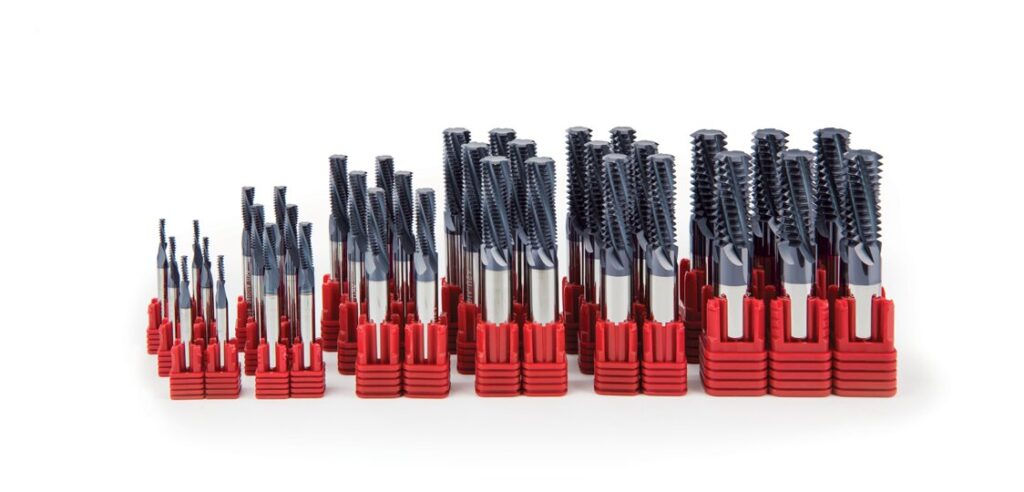
عملية الطحن اللولبي
يتطلب إنشاء خيوط دقيقة من خلال الطحن اهتمامًا دقيقًا بالتفاصيل في كل خطوة. يعتمد النجاح على الإعداد المناسب، ومسارات الأدوات الاستراتيجية، والمراقبة المستمرة طوال العملية.
التحضير: إعداد الماكينة
يبدأ إعداد الماكينة بمحاذاة دقيقة لقطعة العمل وقياسات إزاحة الأداة. يجب تثبيت قطعة العمل بإحكام لمنع الحركة أثناء قوى القطع. تحتاج قيم تعويض طول الأداة والقطر إلى معايرة دقيقة في نظام التحكم الرقمي باستخدام الحاسب الآلي.
تتطلب السرعات والتغذية حسابًا دقيقًا بناءً على خصائص المواد ومواصفات اللولبة وهندسة الأداة. يجب توجيه تدفق سائل التبريد المناسب إلى منطقة القطع لإدارة الحرارة وإخلاء البُرادة.
استراتيجيات مسار الأداة
يحدد تخطيط مسار الأداة جودة اللولبة النهائية وكفاءة التشغيل الآلي. تتبع أداة القطع مسار استيفاء حلزوني أثناء دورانها حول محورها. تحتاج حركات الدخول والخروج إلى انتقالات سلسة لمنع علامات الأداة. يمنع العمق المناسب للقطع لكل مسار انحراف الأداة ويضمن اتساق شكل اللولبة.
الطحن بالتسلق مقابل الطحن التقليدي
يحرك التفريز بالتسلق الأداة في نفس اتجاه دورانها، مما يقلل من انحراف الأداة وينتج تشطيبًا أفضل للسطح. يعمل هذا النهج بشكل جيد في معظم عمليات تفريز الخيوط. يتحرك التفريز التقليدي عكس اتجاه الدوران وقد يتسبب في حدوث رفرفة الأداة، ولكنه يثبت أحيانًا أنه مفيد في مواد معينة أو عند تصنيع أجزاء رقيقة الجدران.
تنفيذ عملية الطحن اللولبي
أثناء التشغيل، يضمن الحفاظ على معلمات القطع الثابتة اتساق اللولبة. تساعد مراقبة تكوين البُرادة على اكتشاف المشكلات المحتملة مبكرًا. تتطلب العملية مزامنة دقيقة بين سرعة عمود الدوران ومعدل التغذية الحلزونية لتحقيق درجة اللولبة الصحيحة. قد تكون التعديلات في الوقت الحقيقي ضرورية بناءً على تآكل الأداة أو تغيرات المواد.
عمليات ما بعد الطحن
بعد الطحن، تحتاج اللولبات بعد الطحن إلى فحص دقة الأبعاد وجودة السطح. تتحقق مقاييس اللولبة من قطر اللولبة وملاءمتها. تشطيب السطح يضمن التقييم الأداء الوظيفي السليم. أي نتوءات تتطلب إزالة دقيقة دون الإضرار بأجنحة اللولب. يزيل التنظيف النهائي البُرادة المتبقية وبقايا سائل التبريد.
مزايا التفريز اللولبي
يحقق المصنعون نتائج متفوقة باستمرار مع تفريز الخيوط مقارنةً بطرق الخيوط التقليدية. تقدم العملية تحسينات قابلة للقياس في جوانب إنتاج متعددة.
الدقة والدقة المحسّنة
يحقق التفريز اللولبي تحكمًا استثنائيًا في الأبعاد من خلال حركات دقيقة باستخدام الحاسب الآلي. تحافظ أنظمة التحكم الرقمي على أعماق القطع والسرعات الدقيقة طوال العملية. وتنتج هذه الأنظمة خيوطًا ذات تفاوتات ضيقة تصل إلى 0.001 بوصة، مما يلبي أكثر المواصفات تطلبًا.
المرونة في أحجام الخيوط والملامح
يمكن لماكينة تفريز اللولبة الواحدة إنتاج أحجام مختلفة من اللولبة عن طريق ضبط مسارات الأدوات. تتعامل العملية مع كل من اللولبة اليمنى واليسرى دون تغيير الأدوات. تسمح تعديلات البرمجة بالتبديل السريع بين معايير اللولبة المختلفة. تقوم نفس الأداة بإنشاء اللولبة الداخلية والخارجية، مما يقلل من احتياجات المخزون.
تقليل أوقات الإعداد المخفضة
تحدث تغييرات الأدوات بسرعة مع حاملات الأدوات الحديثة والإزاحات المحددة مسبقًا. تستغرق تعديلات البرنامج لأحجام اللولب المختلفة دقائق بدلاً من ساعات. لا حاجة لتمريرات متعددة بأدوات مختلفة مما يوفر وقت إعداد كبير.
فعالية التكلفة في الإنتاج
يقلل التفريز اللولبي من هدر المواد من خلال التحكم الدقيق وتقليل القِطع المخردة. تعمل أنماط التآكل الموزعة على إطالة عمر الأداة بشكل كبير. يؤدي انخفاض عدد الأدوات المتخصصة إلى انخفاض تكاليف المخزون. تزيد أزمنة الدورات الأسرع من الإنتاجية الإجمالية لكل ساعة ماكينة.
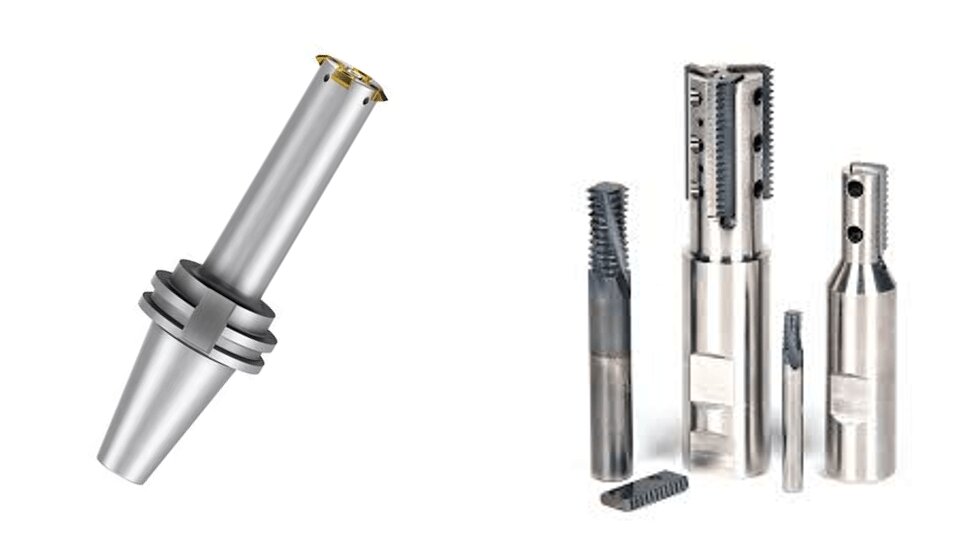
عيوب الطحن اللولبي
بينما يوفر تفريز اللولبة العديد من الفوائد، يجب على المصنعين مراعاة بعض القيود عند التخطيط لعمليات التفريز اللولبي.
اعتبارات الاستثمار الأولي
يتطلب تفريز الخيوط معدات متطورة بنظام التحكم الرقمي باستخدام الحاسب الآلي ذات قدرات متعددة المحاور. تكلف الماكينات أكثر من معدات اللولبة الأساسية.
المتطلبات الفنية
يتطلب إنشاء خيوط عالية الجودة مهارات برمجة دقيقة ومعرفة تقنية. يجب على المشغلين إتقان مسارات الأدوات المعقدة ومعلمات القطع. حتى الأخطاء الطفيفة في البرمجة يمكن أن تؤدي إلى خيوط معيبة.
عوامل الوقت في عمليات التشغيل الصغيرة
يستغرق تفريز اللولبة وقتًا أطول للخيوط اللولبية المفردة مقارنةً بالاستدقاق. تتطلب حركة الإقحام الحلزونية وقتًا أطول من طرق الثقب المباشر.
القيود المادية
تشكل بعض المواد تحديات لعمليات تفريز اللولبة. قد ينتج عن المواد اللينة تشطيبات لولبية رديئة بسبب الانحراف، وتزيد المواد شديدة الصلابة من معدلات تآكل الأدوات بشكل كبير.
أفضل الممارسات لطحن الخيوط اللولبية
يتوقف النجاح في عمليات تفريز الخيوط على اتباع أساليب وإرشادات مجربة. تساعد هذه الممارسات الأساسية على ضمان تحقيق أفضل النتائج مع إطالة عمر الأداة والحفاظ على جودة ثابتة. فيما يلي خمسة اعتبارات مهمة:
- راقب أنماط تآكل الأداة عن كثب وتتبع مقاييس جودة الخيط لإجراء تعديلات المعلمات في الوقت المناسب.
- ابدأ بسرعات قطع متحفظة واضبطها بناءً على خصائص المواد والنتائج الملاحظة.
- حافظ على التدفق والضغط المناسبين لسائل التبريد للتحكم في درجات حرارة القطع وضمان كفاءة إخلاء البُرادة.
- تأمين تشبيك آمن لقطعة العمل لتقليل مخاطر الاهتزاز أثناء عملية اللولبة.
- تكييف استراتيجيات القطع مثل الطحن المتسلق أو الطحن من الأسفل إلى الأعلى عندما يشير تآكل الأداة إلى الحاجة إلى تحسين العملية.
خاتمة
لقد أثبت التفريز اللولبي جدارته في التصنيع الحديث من خلال الدقة الفائقة وتعدد الاستخدامات والموثوقية. عند تطبيق هذه التقنية بشكل صحيح، تقدم هذه التقنية نتائج خيوط ملولبة استثنائية مع تقليل تكاليف الإنتاج. يستمر مستقبل التفريز اللولبي في التطور مع تقدم تكنولوجيا التحكم الرقمي باستخدام الحاسب الآلي وابتكارات أدوات القطع.
هل تحتاج إلى حلول تفريز لولبية دقيقة؟ يقدم فريق الخبراء لدينا خدمات بنظام التحكم الرقمي من الدرجة الأولى، بدءًا من النماذج الأولية وحتى الإنتاج الضخم. اتصل بشنجن اليوم.
الأسئلة الشائعة
ما هي المواد التي يمكن تفريزها باستخدام الطحن؟
يعمل الطحن اللولبي بفعالية عبر العديد من المواد. يستجيب الألومنيوم والصلب بشكل جيد للغاية لهذه العملية. وتتطلب المواد الأكثر تعقيدًا مثل التيتانيوم والإينكونيل معايير قطع محددة.
هل تفريز اللولب أفضل من التفريز اللولبي؟
يتفوق تفريز اللولب على التفريز اللولبي في المواد الصعبة وأحجام اللولب الأكبر. يقلل من خطر كسر الأداة في الثقوب العميقة. قد يكون الثقب اللولبي أكثر كفاءة في اللولبات الصغيرة والبسيطة في المواد اللينة. يعتمد الاختيار على متطلبات التطبيق المحددة.
ما هي العوامل التي تؤثر على اختيار طريقة الخيوط؟
تؤثر خصائص المواد بشدة على اختيار طريقة الخيوط الملولبة. يؤثر حجم الإنتاج على الجدوى الاقتصادية لكل طريقة. يلعب حجم الخيط ومتطلبات الجودة أدوارًا حاسمة. وغالبًا ما تحدد قدرات المعدات المتاحة الاختيار النهائي.
هل يمكن لماكينة التفريز CNC قطع الخيوط؟
يمكن لماكينات التفريز الحديثة باستخدام الحاسب الآلي المزودة بالإقحام الحلزوني إنتاج خيوط لولبية. تحتاج الماكينة إلى إمكانيات برمجة مناسبة وتحكم كافٍ في المحاور. تتعامل معظم ماكينات CNC الحالية بفعالية مع عمليات تفريز اللولب.
مهلا، أنا كيفن لي

على مدى السنوات العشر الماضية، كنت منغمسًا في أشكال مختلفة من تصنيع الصفائح المعدنية، وشاركت رؤى رائعة هنا من تجاربي عبر ورش العمل المتنوعة.
ابقى على تواصل

كيفن لي
لدي أكثر من عشر سنوات من الخبرة المهنية في تصنيع الصفائح المعدنية، وتخصصت في القطع بالليزر، والثني، واللحام، وتقنيات معالجة الأسطح. كمدير فني في شنغن، أنا ملتزم بحل تحديات التصنيع المعقدة ودفع الابتكار والجودة في كل مشروع.

